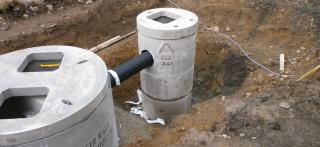
Downstream Defender® Provides the ‘Missing Link’ in Scottish SuDS Dilemma
Downstream Defender® cuts the environmental impact of an £8 million Scottish trunk road realignment.
Situation
Plans to rebuild a two mile stretch of the A7 near Auchenrivock, Dumfries, originally involved the design of three SUDS ponds to cut flooding risk and treat pollutants and sediments in a sensitive rural location. But the development of the most northern of the ponds could have led to severe construction delays and traffic disruption
The new single carriageway was constructed in hilly terrain to the west of the original road and the only level ground available for a SuDS pond was some distance away," Resident Engineer James McLeod of Dumfries and Galloway Council’s in-house Design Function, DGDesign. "To construct a third pond would have meant building a new 300 m length of sewer and required major sewer works to be carried out during the road construction phase, with a potential consequent road closure. It was identified that a Downstream Defender® could provide a space-saving solution which achieved the required level of pollutants and sediments removal before discharging stormwater into the nearby River Esk. The remaining two ponds were redesigned to accommodate the additional stormwater storage capacity.
Solution
Hydro International’s advanced vortex separator, the Downstream Defender® was installed to provide pollutant and sediment removal in a very small footprint compared to a SuDS pond. The treated surface water is discharged into the River Esk.
Outcome
The new stretch of the A7 between Carlisle and Langholm has been built to replace the original winding trunk road which had no overtaking opportunities and a poor accident record. The Downstream Defender® is the first to be constructed on Transport Scotland’s trunk road network.
Cutting the environmental impact of the scheme was a key consideration for the council and Transport Scotland. A SuDS-compliant drainage solution was one of a range of strict environmental requirements, including measures to facilitate the movement of fish and mammals, preserve habitats and provide sympathetic landscaping.
As part of the project, the original road is to be de-trunked and part of it converted into a cycle path.

















